

Chapter 5
"Bleeding Kansas" 1854-1861
Missouri Compromise 1820
Missouri = slave state
Maine = free state
Keep the balance of the states in Congress
360- 30’ line of separation for the future
The balance of political power was very important to both regions. When Alabama joined the Union as a slave state in 1819, it made the balance of power equal in the legislature. The Senate had 22 members from slave states and 22 from free states.
Map

Compromise of 1850
California added as a Free State
Even up again
Texas was added as slave state 1845
Slavery
First slaves brought in 1619
Minor use
South used as source of labor
King Cotton – Cotton Gin – Eli Whitney



Kansas organization
Fall of 1854 president Franklin Pierce appoints Andrew H. Reeder territorial governor
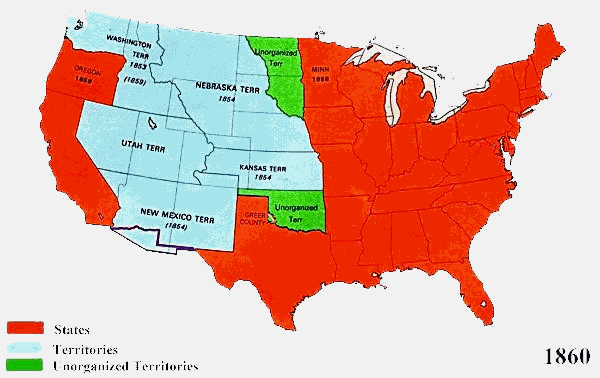
Kansas/Nebraska Act
May 30, 1854
Created twin territories of Kansas and Nebraska
U.S. law authorizing the creation of Kansas and Nebraska, west of the states of Missouri and Iowa and divided by the 40th parallel. It repealed a provision of the Missouri Compromise (1820) that had prohibited slavery in the territories north of 36
° 30', and stipulated that the inhabitants of the territories should decide for themselves the legality of slaveholding.Popular Sovereignty

Popular Sovereignty - Steven A. Douglas
let the people decide
-- against Missouri Compromise 1820
New England Emigrant Aid Society


Henry Ward Beecher
Southern Emigrant Aid Society
In Fort Scott, trouble began in the summer of 1856 when a group of about 30 pro-slavery settlers from South Carolina arrived in Bourbon County. It was suspected that they were sponsored by the Southern Emigrant Aid Society and were members of the Dark Lantern Societies. These societies terrorized free-state settlers and attempted to drive them from Kansas.
"Uncle Tom’s Cabin"
Harriet Beecher Stowe
(June 14, 1811 - July 1, 1896)
Daughter of Congregational minister Lyman Beecher and Roxana Foote Beecher. She is best known for writing Uncle Tom's Cabin in which she expresses her moral outrage at the institution of slavery and its destructive effects on both whites and blacks. She portrays the evils of slavery as especially damaging to maternal bonds, as mothers dread the sale of their children. Written and published in installments between 1851 and 1852, publication in book form brought financial success.
Publishing nearly a book a year between 1862 and 1884, Stowe moved from her early focus on slavery in such works as Uncle Tom's Cabin and another novel, Dred, to deal with religious faith, domesticity, and family life.

" So you’re the little lady that caused such a great war"- Abraham Lincoln
Free State vs. Pro-slavery
Kansas becomes the battle ground that will lead to Civil War
Sumner / Brooks incident

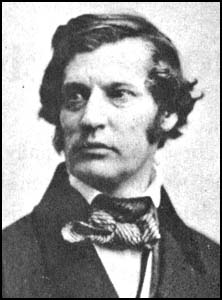

Jayhawkers

Jayhawking was a synonym for stealing, and Jayhawkers stole, burned, and occasionally murdered for the Union cause in the guerilla warfare that raged in the area before, during, and after the Civil War. Their Confederate counterparts were called Bushwhackers and were cut from nearly the same cloth as Jayhawkers. Both were quasi-military forces made up so-called border ruffians who used the war as an excuse to continue the violence that began with the passage of the Kansas-Nebraska Act in 1854. Occasionally one or the other factions would contribute a significant military action to the war effort, but their style of warfare was mostly an embarrassment ti their governments. Buswhackers such as "Bloody" Bill Anderson and William C. Quantril recruited murderers such as Frank and Jesse James and their cousins, the Younger brothers. They used these savages to pillage stagecoaches, banks, and towns, and to massacre any Union soldiers they could catch. Jayhawkers were generally not as blood thirsty as Bushwhackers but were as ruthless in other ways. Led by men such as horse thief Charles R. "Doc" Jennison and U.S. Congressman James H. Lane, they preyed upon the friends and families of the Bushwhackers. By the end of the war, Jayhawkers had turned the western counties of Missouri into a depopulated and burned-out wasteland.
Charles "Doc" Jennison

John Brown

Summer 1856, Kansas Territory
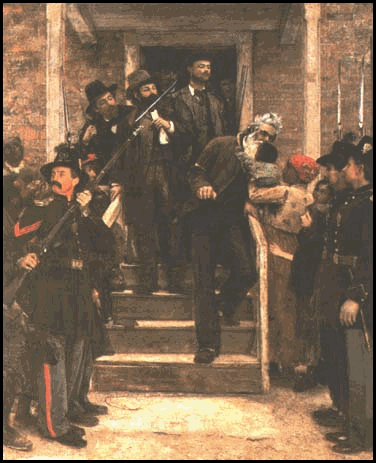
Metropolitan Museum of Art
"Last Moments of John Brown" by T. Hovenden
Fanatic John Brown
Came to Kansas from Ohio
Settled near Osawatomie
Very well known "abolitionist"
Responsible for several murders
"The Settlement of Kansas" by John Steuart Curry
Located on the second floor wall of the Kansas State Capitol in Topeka
Brown’s Raid at Harper’s Ferry
Abolitionist believe in immediate end to slavery
Brown felt the only way was through bloodshed
Need an Army
Need weapons for army
Arm the slaves of the south
Capture arsenal at Harper’s Ferry, Virginia
Kills U.S. troops
U.S. Army called in under the command of Robert E. Lee
Lee captures Brown
Put on trial sentenced to death
Bushwackers
William T. Anderson
"Bloody Bill"

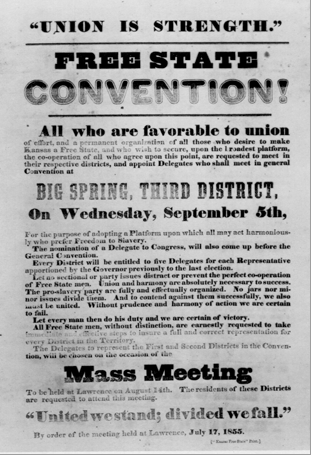
Territorial Government
Statehood Process
Territory must apply to Congress for Statehood
Population requirement
Constitution must be written and approved by the citizens of the territory
(popular sovereignty)Congress must approve of the State’s Constitution
Topeka Constitution 1855
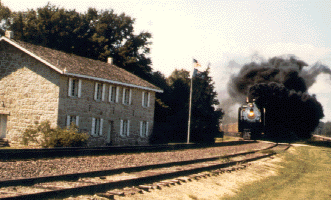
1st attempt at a Constitution
Refused by President Pierce on the basis that the constitution did not reflect the citizens of Kansas
provided for a Free State Kansas
Proslavery raid on Lawrence
On the 20th of August, a body of between three and four hundred crossed the State line at sundown. Riding all night, they reached Lawrence at daybreak. They dashed into the town with a yell, shooting at everybody they saw. The surprise was complete. The hotel, and every point where a rally would be possible, was seized at once, and the ruffians then began the work of destruction. Some of the citizens escaped into the fields and ravines, and some into the woods, but the larger portion could not escape at all. Numbers of these were shot down as they were found, and often brutally mangled. In many cases the bodies were left in the burning buildings and were consumed. The Rebels entered the place about five o'clock, and left between nine and ten. Troops for the relief of the town were within six miles when the Rebels went out. One hundred and forty-three were left dead in the streets, and about thirty desperately wounded. The main street was all burned but two stores. Thus, about seventy-five business houses were destroyed, and nearly one hundred residences. They destroyed something near two millions of property, left eighty widows and two hundred and fifty orphans, as the result of their four hours' work. Scenes of brutality were enacted, which have never been surpassed in savage warfare. The picture is redeemed only by the fact that women and children were in no case hurt."
Potowatomie Massacre

John Brown revenging the destruction of Lawrence
With his sons butcher five pro-slavery men camped along Potowatomie Creek
Battle of Black Jack
Henry Pate – proslavery leader
Fight with John Brown and his men near Baldwin City
Claimed to be the first organized military battle between free and pro-slavery forces
Brown wins
captures most of Pate's men
Proslavery group retreats to Osawatomie
Destroy four houses
Lecompton Constitution 1857

Three miles north is Lecompton, famous in the latter 1850's as headquarters of the Proslavery party in Kansas. The "bogus" legislature of 1855 made it the territorial capital and Congress appropriated $50,000 for a capitol building which was never completed. Lecompton was served by stagecoach, steamboat, and ferry. With a land office and other Federal Agencies, it prospered until the downfall of the slave power in Kansas. Gov. Charles Robinson and many free-state leaders were imprisoned there during 1856-1857. Still to be seen is the legislative hall in which the Lecompton Constitution was framed in 1857.
Lecompton Constitution written by proslavery group
Free-state voters boycott the polls
Fradulent election
Vote early, vote often
5000 citizens - 8000 votes cast
Congress and the President refuse admittance
Leavenworth Constitution 1857
Free state government
Territorial Governor of Kansas did not sign
Written as a reaction to the Leavenworth Constitution
Kansas refused statehood
Wyandotte Constitution 1859
Barred slavery in Kansas
Fixed the boundary
Congress accepts
Kansas Statehood
Kansas – 34th state on Jan. 29, 1861
Charles Robinson first governor
Fort Scott

The former officer's quarters, was opened as the Fort Scott or Free State Hotel.

Located right across the parade ground was the Western or Pro-Slavery Hotel, a former infantry barracks.

The residents of Fort Scott were predominately pro-slavers, while free-staters and abolitionists dominated the surrounding countryside. Radicals of each faction terrorized the town throughout the "Bleeding Kansas" era.
By 1858, trouble had intensified in southeast Kansas. Radical elements from other theaters of the conflict were now converging on this area. James Montgomery became a leader of free state forces and was involved in several violent incidents.
In April of 1858, Montgomery and his men fought U. S troops stationed at Fort Scott in the battle of Paint Creek. One soldier was killed in this encounter.
Marais des Cygnes Massacre
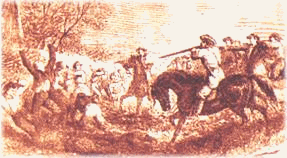
"...A stain that shall never bleach out in the sun! ..."
In May of 1858, Montgomery and his men drove pro-slavery forces from Linn County. In retaliation, eleven free-staters were pulled out of their homes, taken to a ravine and shot down. This incident, known as the Marais des Cygnes Massacre was rumored to have been plotted in the Western Hotel.
May 9, 1858
Charles Hamilton- bushwacker ran out of Kansas
11 men lined up and shot
All fell
Five killed- five wounded- one unhurt
marker

On June 5, 1858, Montgomery and his raiders tried to burn down the Western Hotel. Several shots were fired into the hotel and surrounding homes, but the hotel was saved.

He ran a hay wagon up against the side of Western Hotel, set it on fire, broke out the windows, and of course the screams of fire, fire, arose, and the residents left the hotel, and they were fired upon, and many of them were wounded, none were killed.
Violence, such as this, caught the governor's attention. On June 15, 1858, he held a meeting at the Western Hotel in order to settle political unrest. While this meeting nearly broke out into a riot, it was successful. Peace and quiet reigned for a brief five-month period.
Montgomery and his raiders struck again in December of 1858 when he rescued Benjamin Rice, a free-soiler. Rice had been arrested for murder and was imprisoned in the Fort Scott Hotel. Montgomery claimed that he was jailed illegally, so he came to Fort Scott to free him.
In the struggle following Rice's rescue, former Deputy Marshal John Little, a pro-slavery advocate, fired shots into the ranks of the free-staters. Little peered out of a window of his father's store (the former post headquarters) to observe the effects of the shooting. His movement was noted by a free stater who shot and killed him. Little's fiancé, Gene Campbell, wrote Montgomery a letter reprimanding him and saying that he was a "minister of the devil, and a very superior one too..."
Fort Scott
January 4, 1859
Montgomery:
Listen to me. Today I heard that you said in a speech a few days ago that you were not sorry you had killed John Little. That he was not killed too soon. Can you before God say so? Oh, the anguish you have caused. He was one of the noblest men ever created, brave and true to his country and to his word. You can't prove that he ever injured an innocent person.
A few days more and we were to have been married, then go south to trouble you no more. But through your influence, he was killed. He was sent to another world without even time to pray or to say goodbye to his friends. But thanks to God, though you did kill his body, you can't touch his soul. No. No, it is in the spirit land. Now the cry of "the Osages are coming!" can awaken him no more. He quietly sleeps in our little graveyard.
But remember this. I am a girl, but I can fire a pistol. And if ever the time comes, I will send some of you to the place where there is "weeping and gnashing of teeth". You, a minister of God? You mean a minister of the devil, and a very superior one too. I have no more to say to you and your imps. Please accept the sincere regards of your future repentance.
Gene Campbell


Civil War
Lincoln elected Nov, 1860
Southern States secede
April 12, 1861
Southern forces fire on Fort Sumter, S.C.
Issue of Union vs. Confederation
Slavery
Kansas in the Civil War
20,000 Kansas casualties
Many volunteers
Only major battle was at Mine Creek
Fort Scott in the War
Headquarters of the Army of the Frontier
General James G. Blunt
Troops fought in KS., Mo., and Ark.
Some much further east
Fort Scott was reactivated by the United States Army during the Civil War and it became very large military complex, a large quartermaster supply depot or recruitment center, a training center and a haven for refugees during the Civil War. Thousands of troops stationed here and passed thorough Fort Scott at that time
There were thousands of tons of quartermasters stores located here in Fort Scott, supplies, were purchased from local farmers, like hay and straw and animals and horses and mules, the quartermaster would be buying 500, 600, 700 mules at a time. He would be buying as much as 2,000 tons of hay at a time.
Black Troops


The First Kansas Colored commenced forming under the direction of James H. "The Grim Chieftain" Lane in August 1862 and was mustered into U.S. service under the command of Colonel James M. Williams, formerly of the Fifth Regiment Kansas Volunteer Cavalry, on January 13, 1863. The delay was due to an opposition to the arming of black troops among many in the North and federal policy that reflected this prejudicial attitude. Despite the existence of a widespread national reticence, many Kansans advocated the use of black troops early on, and during the fall of 1862, a portion of the regiment engaged in battle with a rebel force at Butler, Mo., thus gaining distinction as the first "colored soldiers in the Union army" tested in battle
Black troops were brought into the Union army in many places in the U.S.
First was Fort Scott
Total of about 2080 in the 1st and 2nd Kansas Colored regiments
180,000 nation wide
Battle of Mine Creek
In October , 1864, a Confederate Army under Gen. Sterling Price was defeated near Kansas City. He retreated south, crossed into Kansas, and camped at Trading Post. Early on the morning of October 25 Union troops under Generals Pleasanton, Blunt, and Curtis forced him from this position, and a few hours later the Battle of Mine Creek was fought over these fields. Confederate forces were thrown into confusion as they tried to cross the steep slippery banks of the stream. In the close fighting on the bottoms hundreds of Rebel soldiers were captured, including General Marmaduke, who was taken by a 20-year-old private. Although Union forces missed a chance to destroy Price's army the defeat was decisive enough to end the threat of a Rebel invasion of Kansas. About 25,000 troops were engaged, more than in any other Kansas battle.
Battle of Mine Creek is also known as the Battle of Osage or the Battle of Marais des Cygnes
Marmiton River
Other Names:
Shiloh Creek, Charlot’s FarmLocation: Vernon County
Campaign: Price’s Missouri Expedition (1864)
Date(s): October 25, 1864
Principal Commanders: Brig. Gen. John H. McNeil [US]; Maj. Gen. Sterling Price [CS]
Forces Engaged: Two brigades, provisional cavalry division [US]; Army of Missouri [CS]
Estimated Casualties: Unknown
Description: Following the Battle of Mine Creek, Maj. Gen. Sterling Price continued his cartage towards Fort Scott. In late afternoon of October 25, Price’s supply train had difficulty crossing the Marmaton River ford and, like at Mine Creek, Price had to make a stand. Brig. Gen. John S. McNeil, commanding two brigades of Pleasanton’s cavalry division, attacked the Confederate troops that Price and his officers rallied, included a sizable number of unarmed men. McNeil observed the sizable Confederate force, not knowing that many of them were unarmed, and refrained from an all out assault. After about two hours of skirmishing, Price continued his retreat and McNeil could not mount an effective pursuit. Price’s army was broken by this time, and it was simply a question of how many men he could successfully evacuate to friendly territory.
Result(s): Union victory
Quantrill’s Raiders
Band of outlaws and thieves
Bloody Bill Anderson
Frank and Jesse James
Bob and Cole Younger
Military goals put to the side of personal gain
Graphic lawrence

William Clarke Quantrill
The best known guerrilla on the Missouri side (and perhaps of the entire war) was William Clarke Quantrill. Born at Canal Dover, Ohio in 1837, Quantrill had come to Kansas in 1857 to farm. This effort failed and he went west to the Rockies to seek adventure. Back in Kansas just before the outbreak of the war, he cast his lot with the south and joined the Missouri Confederate troops led by Sterling Price. Dissatisfied with a lack of aggressiveness after the battle of Lexington, Missouri in September, 1861, he left the army to take a more active role--bringing guerrilla warfare to Kansas.

Destruction of Lawrence
The climax of Quantrill's guerilla career came on August 21, 1863, when he led a force of 450 raiders into Lawrence, Kansas, a stronghold of pro-Union support and the home of Senator James H. Lane, whose leading role in the struggle for free-soil in Kansas had made him a public enemy to pro-slavery forces in Missouri. Lane managed to escape, racing through a cornfield in his nightshirt, but Quantrill and his men killed 183 men and boys, dragging some from their homes to murder them in front of their families, and set the torch to much of the city.
Conclusion of War
April 9, 1865 Surrender at Appomatox Courthouse, Va.
600,000 deaths in four years
Kansas moves on to the wild west days